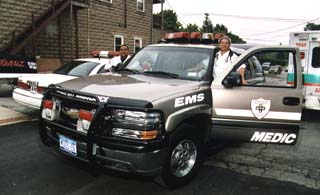
On July 26, Spencerport Volunteer Ambulance's (SVA) newest vehicle was put into service. The Medic 28 Fly Car is a 2003 Chevy Tahoe and replaces the 1992 Crown Victoria. The Tahoe is a welcome addition to the fleet which includes two ambulances, according to volunteers at SVA. A First Response Vehicle has only the most advanced life support equipment on board. It can be used by medics to respond to an emergency when a full ambulance crew isn't available or necessarily needed. It can also help neighboring districts who don't have advanced life support (ALS) coverage. SVA's Tahoe is equipped with the latest in advanced life support equipment including the Zoll M-Series heart monitor and defibrillators. Mercy Flight Central in Canandaigua is the only other facility to have this type of state-of-the-art technology. One of the benefits of the Fly Car is that it can be driven home by volunteers. This effectively means that 24 hours a day, every day of the week, someone can respond immediately to a call. "Because most of our staff is comprised of volunteers, there are several hours in each day when the actual ambulance house can't be staffed. This Fly Car will be driven home by whoever is on call that particular day or night," Jeff Tewksbury, volunteer Chief of Operations for SVA, said. "If a call comes in, rather than having to drive to our facility, pick up the ambulance and then head to the scene, the EMT will be able to respond immediately, saving precious, possibly life saving, minutes. An ambulance would then be dispatched to follow and transport the patient to the hospital if necessary." Being able to administer life support to a victim quickly is crucial and the new Fly Car will play a pivotal role whether on a large scale or small. In the unfortunate event of a major catastrophe the Fly Car can transport a large number of paramedics to the scene of the accident and act as a command post for multiple patients. The complete cost of the Chevy Tahoe was $90,000. The vehicle itself was $38,000 and the additional life support equipment, cabinetry, lights, sirens, lettering, and other accessories that enable it to have the New York State Department of Health designation of "First Response Vehicle" made up the additional $52,000. The Spencerport community donated the funds used for this purchase over the past two years. This money, combined with a New York State Grant acquired with the help of Senator George Maziarz and Assemblyman Charles Nesbitt's offices, and a surprise donation from the 2002 Spencerport Canal Days Committee, enabled SVA to make the purchase. "The $5,000 check from the Canal Days Committee last year was a total surprise and definitely helped us finalize the purchase," Jeff Tewksbury said. "We have a very generous community but we were hesitant to ask them for even more money. The check enabled us to not have to do that, and we're grateful to them." Spencerport Volunteers Ambulance is still largely a volunteer organization but over the years it has become necessary to add some paid employees as not enough volunteers are available. In the mid 1970s, there were 170 regular active volunteers. Today there are 50 who are officially members but only 25 who are active. Spencerport Ambulance covers most of the town of Ogden as well as part of the town of Parma. Tewksbury says he recognizes that it is a huge commitment to volunteer to work in emergency service such as SVA. There is extensive training involved, not just once, but ongoing. Skills have to be kept up to date and tests passed to maintain certification. Some of the current volunteers began through the Explorer Program and stayed on. The SVA recognizes that it needs to get young people involved if it is to continue, he says. Rising costs of operating the ambulance facility is also a concern. The SVA regularly compares their costs to other ambulances nearby to make certain they are in line. The cost of the ambulance "ride" pays for day-to-day operating expenses, but anything major such as the purchase of new equipment or a new vehicle has to come largely from the annual fund drive. To see more information on the new Fly Car or if interested in exploring the possibility of becoming a volunteer, log on to the Spencerport Volunteer Ambulance's web sit at www.spencerportambulance.org. |
